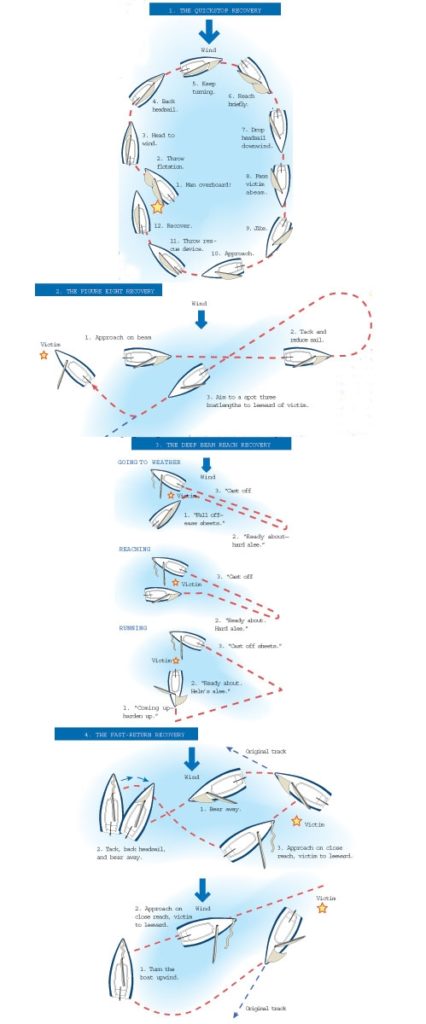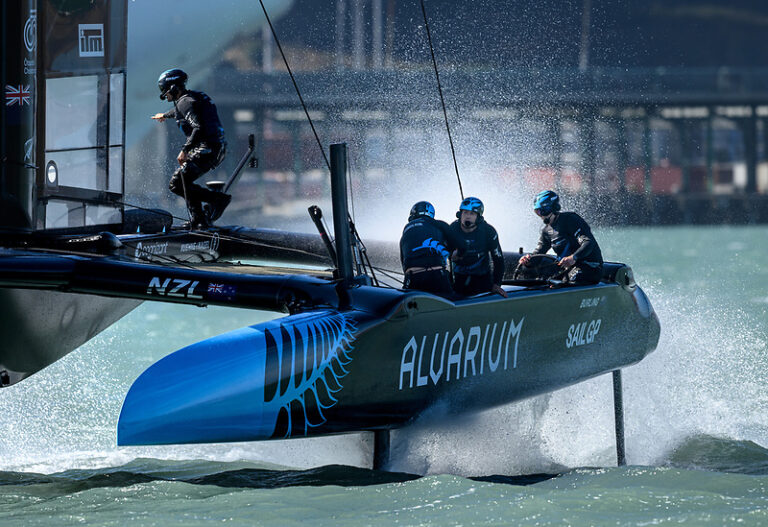
RecoveryDiagrams
Quickstop -Man overboard! Throw flotation. Post spotter. -Bring boat head-to-wind and beyond. -Allow headsail to back and further slow the boat. -Keep turning with headsail backed until wind is abaft the beam. -Head on beam to broad-reach course for two or three lengths, then go to nearly dead downwind. -Drop the headsail while keeping the mainsail centered (or nearly so). The jib sheets are not slacked, even during the dousing maneuver, to keep them inside the lifelines. Hold the downward course until victim is abaft the beam. -Jibe. -Approach the victim on a course of approximately 45 to 60 degrees off the wind. Establish contact with the victim with heaving line or other device. -Effect victim recovery from the windward side. Quickstop Under Spinnaker -The same procedure is used to accommodate a spinnaker. Follow the preceding instructions. As the boat comes head-to-wind and the pole is eased to the head stay, the spinnaker halyard is lowered and the sail is gathered on the fore deck. The turn is continued through the tack and the approach phase commences. -Man overboard! Throw flotation. Post spotter. -Steer to a beam reach immediately. -Tack after about five boatlengths. Here’s where the roller-furling jib can be furled. Continue to bear away after tacking until the boat has turned past the direction of the victim and aim toward a spot about three boatlengths directly downwind of the victim. -Before the boat reaches this spot, it will come to an area where the victim is in a close reach direction from the boat. The eye of the wind and the victim will be about 60 degrees apart. -Head up immediately to the windward side of the victim and release sheets in time for the boat to come to a stop next to the victim. -Make sure the boat comes to a stop by easing the tiller to leeward (toward the victim). As the boat slows it will try to bear away on its own. When it comes to a stop, yocan have the tiller 45 degrees to leeward and the boat won’t head up due to loss of steerageway. At this point, the boat is stabilized and yocan get the victim aboard without the boat trying to sail away. Figure Eight -Man overboard! Throw flotation. Post spotter. -Place helm to weather, steer to deep beam reach (except when already running). -Reverse helm at two boatlengths until steering just to weather of crew. -Cast off all sheets and control speed with mainsheet. -Lay vessel alongside crew providing a lee for person. -Bring crew aboard. In all cases -Man overboard! Throw flotation. Post spotter. If the boat is sailing upwind -Turn the boat downwind, -Tack into the wind about 2 to 2.5 boatlengths abeam of the victim. -Back the jib, briefly getting below the victim. -Approach on a close reach, with the victim on the lee side of the boat. If the boat is sailing downwind -Turn the boat upwind. -Tack into the wind about 2 to 2.5 boatlengths abeam of the victim. -To show a possible variation, here the jib does not need to be backed because the boat is already below the victim -Approach on a close reach, with the victim on the leeward side of the boat.









